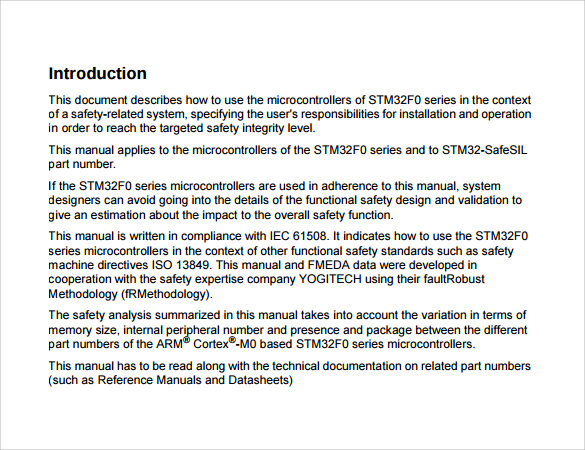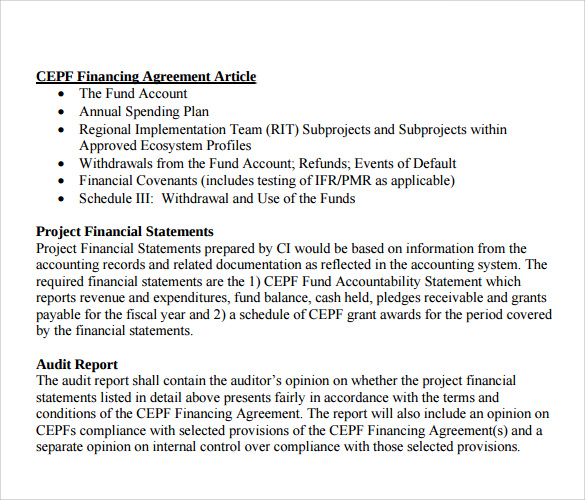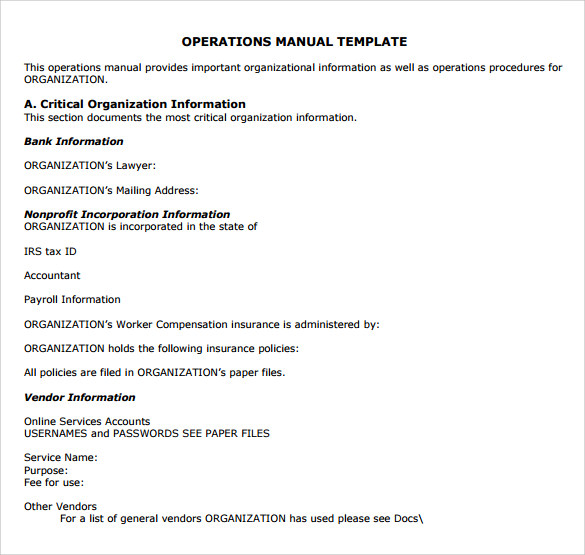Business Operations Fabrication Manual Template
What is process documentation? A process document outlines the steps necessary to complete a task or process. It is an internal, ongoing documentation of the process while it is occurring—documentation cares more about the “how” of implementation than the “what” of process impact. A business is essentially a group of interrelated processes, and if these processes aren’t in writing, breakdowns can occur. Companies have repeatable processes fundamental to their successful operation, thus process documentation serves as a crucial guide for employees and managers to reference.
Why you need process documentation Process documentation is a roadmap for your organization—it helps you identify the current state of a process to know how you can improve it. Any task that is done more than once or completed by multiple people needs to be documented. Doing so provides consistency for your organization and allows you to monitor and revise processes as you go along. Think about it this way—even highly skilled pilots who spend thousands of hours training and flying rely on preflight checklists. They don’t just rely on memory, and no step is considered too minute. Process documentation also allows you to know what people are doing and gain insight into the inner workings of the company. If you don’t document a process, essentially it is being re-designed by someone every time it is repeated.
When an employee leaves, any process knowledge leaves with them unless it has been properly recorded. When you hire new employees, you need a documented process to help them understand their role and how it fits within the overall organization. Documented processes facilitate formal training that allows for smooth onboarding. Process documentation becomes especially crucial when dealing with projects working towards social change, as it focuses on recording the perceptions and changes in perceptions of involved stakeholders. Today’s world consists of users who just want to get things done. They have so many things competing for their attention—they demand intuitive and task-based information, which is where process documentation becomes key. What is the goal?
Process documentation is about keeping track of a process during the execution of a project. The goal is to learn from the implementation so you can adjust the strategy and improve the procedure. Proactively managing processes can:. Eliminate flaws. Reduce time spent on tasks. Decrease costs.
Decrease resources associated with tasks. Notary manual for louisiana. Improve efficiency. Improve overall quality. Increase customer and employee satisfaction Process documentation helps others to realize the changes in behavior and attitudes needed to produce desirable results, and it provides context for processes so that others can see how a project fits into the big picture and what its overall impact is.
Who is involved Project Team: The project team holds responsibility for process documentation. It should become a part of the team activity so that learning becomes integral. However, it can be helpful to have someone not involved in the daily project work own the documentation so that they can focus on recording processes, organizing information, encouraging reflection and distributing information.
That person must stay close to project objectives in order to allow for learning and adaptation as the project progresses. Stakeholders: Any stakeholders involved in a specific project need to be involved in process documentation so that they can learn about others’ opinions and perspectives to help them learn and reflect. Outsiders: Outsiders provide a new and unbiased perspective to help improve processes. Benefits & uses While it may be time-consuming, process documentation provides numerous benefits to your organization that make it well worth the effort. Or By registering I agree to Lucid Software's and.
Tools for process documentation. Tools for capturing the process, such as interviews, group discussions, videos, photographs, observations of users, field diaries, etc.
It can be very helpful to interview those who are experts on the process to ensure you cover all information. Tools for organizing information. You can summarize knowledge in articles, case studies, video bites, etc.
Tools for visualizing processes, such as Lucidchart's. Tools for distributing information, such as email, newspapers, internet, etc. Quality process documentation Not only do you need to document your processes, but you need to document them well. A poorly written procedure can result in failure.
Common causes of poorly-written procedures include:. Not explaining purpose or motivation for the task. Leaving out information. Including unnecessary and distracting information Process documents reveal a great deal about your business philosophy. Poorly written and out-of-date documents can signal a lack of caring.
Current and polished documents empowers teams and improves efficiency. How to make a process document 1. Determine the scope of the document and identify your process. Will it cover one task in a chain of operations or the entire procedure for a manufacturing plant? It is best to have each document cover as small a process as possible.
Consider the audience for whom you are writing. What do they already know about the subject? Where and how are they using the product? What are their demographics? Write a title and introduction describing what the process is, why or when users need to do it and how it fits into the big picture of the organization. Provide context as to why the process is important.
Describe the individuals who will be involved in the process and define their roles. Be sure to use job titles rather than individual names. Identify the process boundaries, or start and end points. Determine the outputs of the process, or what is being produced. Determine the inputs of the process, or the resources needed to perform the process. Brainstorm all the activities needed to complete the process.
This pre-writing strategy is called “listing.” 9. Organize the items from your listing into sequential steps. Be careful how you split up steps. Actions that logically go together should be kept together. Generally, if a step includes more than one verb or the word “and,” it should likely be broken into two steps.
Limit the number of steps—use subheadings for longer tasks and restart numbering under each subheading. Use layers—give users additional information in less prominent text underneath the main step. Expand your steps to ensure all necessary information is included, such as potential hazards, troubleshooting advice or examples. Construct a process flowchart to visually represent the steps. Add any screenshots or graphics that provide clarity. Format your information so that it is easy to scan, read and understand. Make use of bullets, tables, headings, etc.
System Operations Manual Template

Clearly point out how processes connect to each other. For example, at the bottom of the Arranging the Newsletter document, direct readers to the Editing the Newsletter document. Test the process. Watch someone else use it. Ask colleagues to review your document and provide feedback. Remember your documentation is a living document and will need to be continually updated. Best practices.

Make documents public and visible to reach all employees and readers. Store them in a central location—restricting access makes people think it is only relevant to a certain group. Make them easy to edit and search—processes undergo continual change, and new feedback should always be incorporated to improve effectiveness. Review documents at least once a year. Be concise—provide only what is necessary. Be flexible—be willing to adjust a process as needed to ensure steps come naturally.
Get feedback from employees—frontline employees can provide insight on each step’s importance, shortcuts, etc. Capture screen shots for anything difficult to explain.
Use flowcharts—remember a picture is worth a thousand words Include a checklist to ensure every step is completed. Create a template to help standardize documents and facilitate the process. Keep formatting simple. Create a style guide for writers. Create individual documents for different processes and procedures rather than one massive document.

Document when the process was most recently updated. Keep a local backup of the files on your desktop or in a private cloud-based system. Improving the process As you monitor processes, look for specific areas that may need quality overview to improve efficiency, such as when a process moves from one person or team to another. Try to minimize unnecessary movement between departments during a process. Be on the lookout for duplicate tasks, and decide if having both is useful or inefficient.
Entrepreneurs need to avoid business myopia—being too close to your processes can keep you from advancing on the business process procedures journey. You need to work on your business rather than in it to to be able to identify key processes and improve them. Software documentation Software documentation is a type of process documentation that helps with efficient and appropriate use of software.
While originally designed to aid experienced users, it has evolved to include teaching new users. This evolution resulted in task orientation, which is explaining information sequentially, such as how-to’s or tutorials. A good document should encourage the use of the program in the workplace by making it understandable to the user. History The term “process documentation” was first developed by the Philippines National Irrigation Agency at a conference in 1978.
Operations Manual Template
It was used to refer to a project in which social scientists stayed in villages and documented the processes of farmers. It was then passed on to other sectors and regions. For example, the Aga Khan Rural Support Programme (AKRSP) in Qujarat documented their project activities in social forestry and joint forest management. BAIF worked on process documentation of its Community Health Programme for tribal families from Vansda Taluka.
Top Articles
- ✔ 2018 Gmc Sierra Fuel Pump Replacement Manual
- ✔ Conceptual Physics 11th Edition Study Guide
- ✔ Wechsler Individual Achievement Test Iii Technical Manual
- ✔ Mazda 323 P Ba Manual
- ✔ 2013 Ford Fusion Service Manual
- ✔ Volvo Penta Parts Manual
- ✔ Quickbooks Premier 2017 Manuals
- ✔ 93 Olds Cutlass Ciera Service Manual Torrent
- ✔ 2016 Cr 80 Workshop Manual
- ✔ Onan Quiet Diesel Generator 12500 Operators Manual
- ✔ Briggs Vanguard 303700 Service Manual
- ✔ Model Covered Bmw X6 2015 Manuals Repair
- ✔ Biz Cafe Manual
- ✔ 2001 1 6 Xsara Picasso Manual Airbag
- ✔ Car Workshop Manuals Nissan Almera
- ✔ Ricoh Aficio Mp C5000 Service Manual
- ✔ Audi Symphony Manual A4 2007
- ✔ Suzuki Swift Service Repair Manual 2018
- ✔ Tacho Pro 2017 Manual